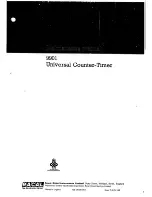
The command string is constructed by using the above commands and value
identifiers, along with the data values that are required. Data values may or may
not contain the decimal point if a decimal point is programmed into the Gemini
2000. The Gemini 2000 will accept the decimal points, however, it does not
interpret them in any way. Leading zeros can be eliminated, however, all trailing
zeros must be present. For example, if a Scale Factor of 1.0000 is to be sent, the
data value can be transmitted as 1.0000 or 10000. If a
“1”
is transmitted, the
Scale Factor will be changed to 0.0001.
The Address command is used to allow a command to be directed to a specific
unit in the Serial Communications Loop. Whenever the unit address is zero,
transmission of the Address command is not required. This is done for
applications which do not require more than one Gemini. For applications that
require several units, it is recommended that each unit in the loop be given a
separate address. If they are given the same address, a command such as the
Transmit Value Command, will cause all the units to respond at the same time,
resulting in erroneous data.
The command string is constructed in a specific logical sequence. The Gemini
2000 will not accept command strings that do not follow this sequence. Only one
operation can be performed per command string. Below is the procedure to be
used when constructing a command string.
1. If the Gemini 2000, to which the command is to be sent, is assigned an
address other than zero, the first two or three characters of the command
string must consist of the Address Command
(N)
and the address number of
the unit
(1-15)
.
2. The next character
(s)
in the command string is the actual command that the
Gemini 2000 is to perform and the value identifier if it pertains to the
command.
(A command such as the Transmit per Print Options, “P”,
command does not require a Value Identifier.)
3. If the change command is being used, the next characters in the command
string are the numerical data value.
4. The last character in the command string is the command terminator
(*)
. This
character must be sent in order to tell the Geminis that the command string is
complete, so that they can begin processing the command.
Below are some typical examples of properly constructed command strings.
(EX. 1)
Change Preset 1 on the Gemini 2000 with an address of 2 to 00123.4.
COMMAND STRING: N2VA1234*
(EX. 2)
Have the Gemini 2000, with an address of 13, transmit the Count value.
COMMAND STRING: N13TC*
As shown, all commands must be terminated with a
“Command Terminator”
(* or 2AH)
. The Gemini 2000 will not process the command until the terminator
is sent. If illegal commands or characters are sent to the Gemini 2000, they still
would need to be terminated by an
(*)
. If they are not terminated, the next
command will not be accepted.
When writing application programs in Basic, the transmission of spaces or
carriage return and line feed should be inhibited by using the semicolon delimiter
with the PRINT statement. The Gemini 2000 will not accept a carriage return or
line feed as valid characters.
(Refer to the listing of a terminal emulation program
which is written in Basic.)
When a
“Change Value”
command is sent to the Gemini 2000, a short amount
of time is required for the unit to process the data. This time increases with the
count rate. During this time, only one additional command may be sent to the
Gemini 2000. This may be done 80 msec after the transmission of the
“Change
Value”
command. After the second command has been transmitted, the unit will
ignore any further commands until 10 msec after both the
“Change Value”
and
second command have been processed. It is recommended that a
“Transmit
Value”
command follow a
“Change Value”
command. If this is done, the
reception of the data can provide a timing reference for sending another
command and will insure that the change has occurred.
The timing diagrams show the timing considerations that need to be made.
–23–
FIG. 2: TIMING FOR SENDING COMMANDS
FIG. 3: TRANSMIT COUNT & RESET COMMAND TIMING
(**)
This is the time that it takes the Gemini 2000 to process the preset.
It varies with the Count Rate and Scale Factor Value.
Содержание GEMINI 1000
Страница 1: ...THE ASTRO LINE SERIES GEMINI 1000 2000 INSTRUCTION MANUAL GEM1 2CVR QXD 4 10 02 11 04 AM Page 1...
Страница 33: ...GEMINI 1000 BLOCK DIAGRAM...
Страница 34: ...GEMINI 2000 BLOCK DIAGRAM...
Страница 39: ...GEMINI 1000 CONNECTIONS CONFIGURATION SWITCH SET UPS FOR VARIOUS SENSOR OUTPUTS SEE NOTE 5...
Страница 40: ...GEMINI 2000 CONNECTIONS CONFIGURATION SWITCH SET UPS FOR VARIOUS SENSOR OUTPUTS SEE NOTE 5...
Страница 53: ...APPENDIX F GEMINI 1000 PROGRAMMING CHART CARD...
Страница 54: ...APPENDIX F GEMINI 1000 PROGRAMMING CHART CARD...
Страница 55: ...APPENDIX F GEMINI 2000 PROGRAMMING CHART CARD...
Страница 56: ...APPENDIX F GEMINI 2000 PROGRAMMING CHART CARD...
Страница 58: ...This page is intentionally left blank...
















































